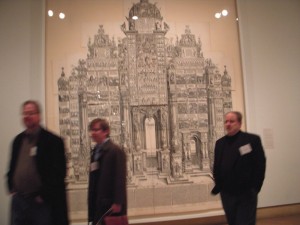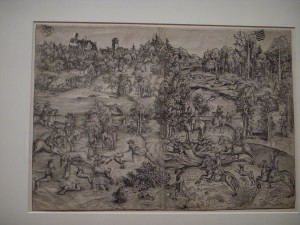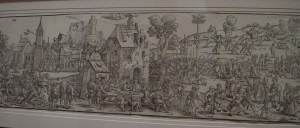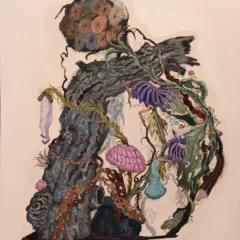This week’s weekly has my review of Grand Scale at the Philadelphia Museum of Art. Below is the copy with some pictures.
Something in the human spirit loves big. Mountains, oceans, hamburgers, paintings, sculpture—the bigger the better. While printmaking would seem to be limited to small by the size of paper and plates, Grand Scale at the Philadelphia Museum of Art shows that ambitious printmakers as far back as the Rennaissance went big—huge — creating mural-sized multi-print images that competed for wall space with tapestries and paintings.

While most of these big mural prints did not survive due to paper’s fragility and the fact that many would have been glued, wallpaper-style, to the wall, the show at the PMA rounds up 40 amazing works by masters from Albrecht Durer to the unknowns. The prints, by and large recount the big stories in human history and myth, from battles and triumphal parades to biblical stories. And because maps have always been seen as beautiful as well as useful, there are wonderful symbolic birds-eye view maps like the one of Venice by Jacopo de’ Barbari made from six woodblocks that convey the power and majesty of the city surrounded by water.
Borrowing imagery from paintings or relief sculpture (especially architectural friezes), printmakers worked mostly in woodblock prints to orchestrate these big montages. And as you can see in the exhibit, the edges of the prints abut perfectly to make a larger whole.

The prints were made in workshops with many hands involved — planners, organizers and coordinators as well as many artists and carvers. Like all prints these were multiples and would have been made to sell. More affordable than tapestries or paintings, the large prints would nonetheless have been made for wealthy patrons with large walls to fill.
Albrecht Durer’s The Triumphal Arch of Maximillian I (1515) is perhaps the biggest work in the show—so big it is showcased outside the gallery in a nearby hallway. This work, commissioned by the Holy Roman Emperor Maximillian I, was produced and distributed like a calling card or gift to remind the receiver of the emperor’s power.

Like all mural-sized works they were meant to be seen from a distance and also studied close up. And they deliver a punch on both levels. The delicacy of line and elegance of poses in the long, scroll-like (or frieze-like) Punishment of Niobe (based on a painting) makes reading the stories up close a delight. From a distance, the work has a sculptural feel and would have acted almost like a sculptural frieze when placed on a wall.
Andy Warhol is the modern-day equivalent of these great big picture makers. His factory-approach to screenprinting on canvas turned prints once again into big objects that competed with paintings for wall space. Nowadays, contemporary artists like Virgil Marti create printed wallpaper environments with their repeat patterns and designs showing the continued viability of great big pictures.
>>Grand Scale, to April 26. Philadelphia Museum of Art. 26th and Ben Franklin Parkway. 215 763 8100. www.philamuseum.org. Adults $14, Seniors $12, Students with ID $10.









